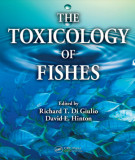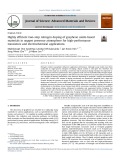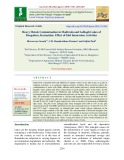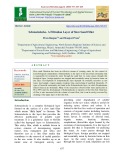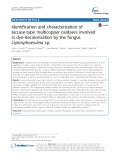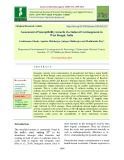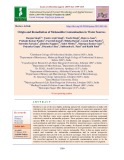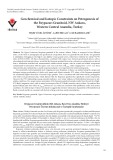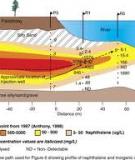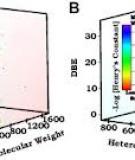
Oxygen contamination
-
Part 1 book "Biomedical tissue culture" includes content: Culture conditions and types of growth media for mammalian cells, cell handling and culture under controlled oxygen concentration, contamination of tissue cultures by mycoplasmas, isolation of breast cancer stem cells by single cell sorting, in vitro, tissue based models as a replacement for animal models in testing of drugs at the preclinical stages, use of cell culture to prove syncytial connection and fusion of neurons.
 123p
123p  muasambanhan07
muasambanhan07
 20-02-2024
20-02-2024
 3
3
 0
0
 Download
Download
-
Part 1 book "The toxicology of fishes" includes content: Introduction, bioavailability of chemical contaminants in aquatic systems, toxicokinetics in fishes, biotransformation in fishes, receptor mediated mechanisms of toxicity, reactive oxygen species and oxidative stress, liver toxicity, the osmoregulatory system, toxic responses of the fish nervous system
 476p
476p  oursky08
oursky08
 02-11-2023
02-11-2023
 5
5
 2
2
 Download
Download
-
Nitrogen content in graphene influences application performance. Although many studies have been conducted on single-process nitrogen (N)-doping, dopant content is still quite low. First, graphene oxide (GO) was hydrothermally nitrogen-doped. This nitrogen-doped reduced graphene oxide (NrGO) was then subjected to secondary plasma treatment. Two nitrogen(N)-doping mechanisms were observed depending on graphene's oxygen functionalized.
 9p
9p  viberbers
viberbers
 09-08-2023
09-08-2023
 9
9
 3
3
 Download
Download
-
Immersion of painted idols and addition of organic wastes in the lake water, as a part of religious activities, is a common religious practice in India. These activities add to the contamination of water with alkali, alkaline earth metals and heavy metals and therefore, degrade water quality and limit conservation of good quality water in the lakes. In this pretext, periodic analysis of Madiwala and Lalbagh lake water were carried out to investigate the impact of idol immersion activities on the lake water quality.
 10p
10p  angicungduoc5
angicungduoc5
 12-06-2020
12-06-2020
 13
13
 2
2
 Download
Download
-
Slow sand filtration has been an effective means of treating water for the control of microbiological contaminants. Schmutzdecke is the layer of the microbial community that is responsible for treating the water through the sand bed. As water passes through this biological layer, foreign particles are trapped and essentially eaten by bacteria forms on this layer. Development of Schmutzdecke layer depends on available microbes in raw water, food supply, oxygen supply, residence time, and wetting of sand bed.
 9p
9p  nguaconbaynhay5
nguaconbaynhay5
 16-05-2020
16-05-2020
 14
14
 0
0
 Download
Download
-
Fungal laccases are multicopper oxidases (MCOs) with high biotechnological potential due to their capability to oxidize a wide range of aromatic contaminants using oxygen from the air.
 13p
13p  viuchiha2711
viuchiha2711
 21-04-2020
21-04-2020
 8
8
 0
0
 Download
Download
-
Inorganic Arsenic (iAs) contamination of groundwater had been a major health hazard. In West-Bengal, many areas had been found to have high level of iAs in groundwater. Chronic exposure to iAs may lead to the generation of Reactive Oxygen Species (ROS) and Reactive Nitrogen Species (RNS). This results in DNA damage, inflammation, impairment of repair activity, thereby culminating in carcinogenesis. Higher telomerase activity may be another manifestation of iAs exposure. This is a pilot study involving 15 subjects residing in an arsenic endemic area of West-Bengal.
 14p
14p  caygaocaolon4
caygaocaolon4
 04-04-2020
04-04-2020
 15
15
 1
1
 Download
Download
-
Distillery is one of the most highly polluting and growth oriented industries in India with reference to the extent of water pollution and the quantity of wastewater generated. Apart from distilleries, fermentation industries, sugar mills, pharmaceutical companies and other molasses based industries are also responsible for contamination and generation of waste water. The distillery waste water contains dark brown colored recalcitrant compounds collectively termed as melanoidin polymers. These polymers cause oxygen depletion and increase BOD.
 17p
17p  cothumenhmong1
cothumenhmong1
 08-12-2019
08-12-2019
 16
16
 0
0
 Download
Download
-
The Upper Cretaceous Beypazarı granitoid of the western Ankara, Turkey, is composed of two diff erent units, on the basis of petrography and geochemical composition; these are granodiorite and diorite. The granitoid is subalkaline, belonging to the high-K calc-alkaline I-type granite series, which have relatively low initial 87Sr/86Sr ratios (0.7053–0.7070).
 25p
25p  vidonut2711
vidonut2711
 09-11-2019
09-11-2019
 6
6
 1
1
 Download
Download
-
Water-quality engineering is a specialty area in environmental engineering that includes the subspecialties of water treatment, wastewater treatment, and water-quality control in natural systems. This textbook is intended to encompass the latter subspecialty, and the content of this book constitutes baseline knowledge expected of water-quality engineers and managers.
 628p
628p  tiendat_cg
tiendat_cg
 26-09-2013
26-09-2013
 82
82
 15
15
 Download
Download
-
If the soil becomes saturated, oxygen may become scarce and in anoxic conditions, denitrifying bacteria may convert the nitrate to nitrogen gases (NO, N2O, and N2). Nitrogen converted to these gases becomes unavailable for plant uptake or for surface water contamination. Additionally, saturated soil during the growing season is harmful to many crops like maize that cannot tolerate low oxygen concentrations in the root zone for more than a few days.
 0p
0p  tainhacmienphi
tainhacmienphi
 19-02-2013
19-02-2013
 43
43
 2
2
 Download
Download
-
Water temperature plays an important role in signaling biological functions such as spawning and migration, and in affecting metabolic rates in aquatic organisms. Altering natural water temperature cycles can impair reproductive success and growth patterns, leading to long-term population declines in fisheries and other classes of organisms. Warmer water holds less oxygen, impairing metabolic function and reducing fitness.
 0p
0p  saimatkhauroi
saimatkhauroi
 01-02-2013
01-02-2013
 48
48
 2
2
 Download
Download
-
In the last year the Blacksmith Institute and Green Cross Switzerland have been using field studies and expertise in pollution analysis to prepare estimates on the contribution of industrial toxic pollutants to the burden of disease. The estimates in this report are based on information collected through the Blacksmith Institutes Toxic Sites Identification Program (TSIP). This program is an ongoing process to identify and screen contaminated sites in low and middle-income countries.
 38p
38p  saimatkhauroi
saimatkhauroi
 01-02-2013
01-02-2013
 60
60
 3
3
 Download
Download
-
An additional benefit of hydrogen peroxide and Fenton's Reagent is the temporary increase of oxygen levels in and around the treatment area. The increased oxygen levels at the fringes of the treatment area can enhance naturally occurring aerobic biodegradation processes that reduce contaminant mass. While there may be concerns about oxidizing hydrocarbon-degrading bacteria in the chemical oxidation treatment area, many studies have shown that soil cannot be readily sterilized by Fenton's Reagent and that microbial populations rapidly rebound following chemical oxidation treatment.
 46p
46p  cao_can
cao_can
 29-12-2012
29-12-2012
 60
60
 6
6
 Download
Download
-
Controlled oxidation is increasingly being practiced using solid peroxides, pH modifiers, and catalysts that promote the generation of free radicals. This new approach moderates the rate of dissolution and peroxide generation, which in turn controls that rate of reaction between peroxide and the petroleum contaminants. The use of slurried peroxides creates the opportunity to release oxidants and oxygen over a longer period, which can promote subsequent aerobic remediation.
 182p
182p  cao_can
cao_can
 29-12-2012
29-12-2012
 80
80
 12
12
 Download
Download
-
Hydrogen peroxide is a strong oxidant that can be injected into a contaminated zone to destroy petroleum contaminants. When injected to groundwater, hydrogen peroxide is unstable, and reacts with organic contaminants and subsurface materials. It decomposes to oxygen and water within hours of its introduction into groundwater generating heat in the process. Peroxide is typically shipped to a remediation site in liquid form at dose concentrations ranging from five percent to 50 percent by weight.
 240p
240p  cao_can
cao_can
 29-12-2012
29-12-2012
 64
64
 9
9
 Download
Download
-
Remedial strategies for petroleum UST sites that include a combination of active source zone treatment with enhanced natural attenuation outside the contaminant plume core may consider chemical oxidation technologies. Many chemical oxidation techniques also provide residual dissolved oxygen that is used by aerobic microorganisms to biodegrade contaminants. In addition, these technologies may also oxidize reduced electron acceptors (e.g., nitrogen to nitrate, sulfides to sulfate), which are then used by anaerobic microorganisms to biodegrade contaminants.
 51p
51p  cao_can
cao_can
 29-12-2012
29-12-2012
 73
73
 5
5
 Download
Download
-
Soil reactivity with chemical oxidants is also important when considering the costs of the use of chemical oxidation. Excessive loss of a chemical oxidant that is reacting with organics in soil, instead of reacting with the contaminants, may preclude the use of the technology as an economically viable approach to site remediation. Different chemical oxidation technologies are most appropriate for particular hydrogeologic conditions. For example, Fenton’s Reagant may not be ideal for groundwater with high concentrations of carbonate.
 158p
158p  cao_can
cao_can
 29-12-2012
29-12-2012
 85
85
 9
9
 Download
Download
-
Concurrent treatment of source area saturated and unsaturated zones usually requires the integration of chemical oxidation with other remedial technologies that target unsaturated zone contamination (e.g., soil vapor extraction). Frequently, soil vapor extraction, which is used to treat the unsaturated zone, is included as a component of chemical oxidation remedial solutions even if there is no specific need to treat unsaturated soils in the source area.
 73p
73p  cao_can
cao_can
 29-12-2012
29-12-2012
 51
51
 3
3
 Download
Download
-
The hole closing reported in this letter is certainly not caused by deposition of carbon-rich material by the electron beam, a common phenomenon in electron microscopy. The observation that large pores expand is in direct contradiction with potential contamination growth. Secondly, electron-energy-loss spectra (EELS) locally obtained on the material that filled a nanopore clearly show the presence of silicon and oxygen,but the absence of any carbon (detection limit was less than 2%).
 23p
23p  quynho77
quynho77
 13-11-2012
13-11-2012
 24
24
 0
0
 Download
Download
CHỦ ĐỀ BẠN MUỐN TÌM









